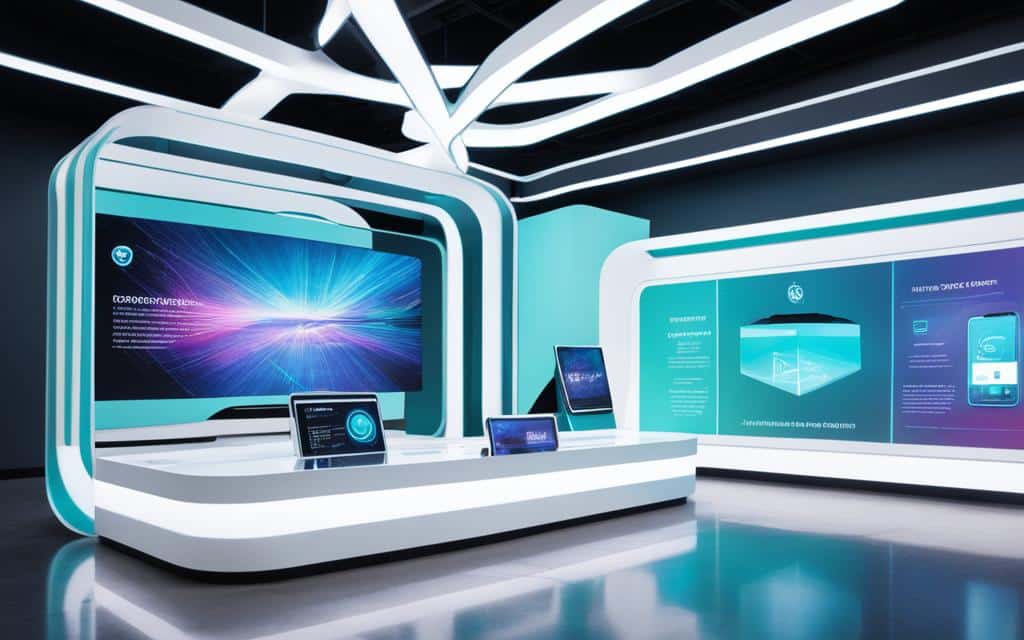Table of Contents
In today’s rapidly evolving landscape, the future of branding is being shaped by various trends and predictions. As businesses navigate this dynamic environment, staying ahead of future branding trends is crucial in redefining their business identity and maintaining a strong market presence.
Hyper-Personalization and Data-Driven Insights
Brands are embracing hyper-personalization to deliver personalized experiences to consumers. This involves analyzing vast amounts of customer data, including browsing behavior and purchase history, using AI algorithms and machine learning. By understanding consumer preferences and trends, brands can tailor their content, products, and marketing efforts to meet individual needs and foster strong connections with their audience. Data-driven insights are essential in informing branding strategies and helping brands make educated decisions to improve customer experiences and messaging.
| Data-Driven Insights | Benefits |
|---|---|
| Improved Customer Understanding | Brands can gain a deeper understanding of their customers by analyzing data and identifying their preferences, pain points, and behaviors. |
| Personalized Product Recommendations | With access to customer data, brands can provide tailored product recommendations based on individual preferences, increasing the chances of conversion and customer satisfaction. |
| Targeted Marketing Campaigns | Data-driven insights allow brands to segment their audience and create targeted marketing campaigns that resonate with specific customer segments, improving engagement and ROI. |
| Enhanced Customer Experiences | By analyzing customer data, brands can identify pain points and areas for improvement, enabling them to create personalized experiences that address individual needs and preferences. |
“Data is the new oil, and insights derived from it empower brands to create personalized experiences that truly resonate with their customers.”
Harnessing the Power of Customer Data
To achieve hyper-personalization, brands need to leverage customer data effectively. This can be done by:
- Collecting and organizing customer data from various touchpoints, including websites, social media, and CRM systems.
- Applying advanced analytics and AI algorithms to derive meaningful insights from the data.
- Utilizing the insights to create customer segments and develop personalized marketing strategies.
- Continuously analyzing and refining the data to adapt to changing customer preferences and behaviors.
By adopting data-driven strategies, brands can stay ahead of the competition and deliver tailored experiences that drive engagement, loyalty, and growth.
Real-Life Example: Amazon’s Personalized Recommendations
Amazon, one of the pioneers of hyper-personalization, leverages customer data to provide personalized product recommendations. By analyzing browsing behavior, purchase history, and other data points, Amazon’s recommendation engine suggests products that align with individual interests and preferences. This data-driven approach has significantly contributed to Amazon’s success in delivering personalized experiences and increasing customer satisfaction.
Data-driven insights fuel hyper-personalization, enabling brands to make informed decisions and create meaningful connections with their customers. By understanding individual preferences and tailoring experiences accordingly, brands can build trust, loyalty, and long-term customer relationships.
Graphic and Video-Centric Content
Graphic and video-centric content is revolutionizing the way brands interact with their audience. With platforms like Instagram, TikTok, and YouTube, brands now have the power to deliver their stories and values through captivating visual storytelling. This type of content catches attention quickly and leaves a lasting impression on viewers.
Brands are also embracing live streaming and interactive video experiences, allowing them to establish authentic connections with their audience in real-time. This immersive approach not only engages viewers but also encourages co-creation of content, fostering a sense of community and strengthening emotional bonds.
Visual storytelling through graphic and video-centric content has become an essential part of brand communication. It enables brands to convey their message more effectively, evoke emotions, and create memorable experiences. By leveraging the power of visual storytelling, brands can engage their audience in a way that resonates on a deeper level.
To illustrate the impact of graphic and video-centric content, below is an example of how a brand successfully utilizes visual storytelling to engage its audience:
“[Brand Name], an innovative makeup brand, understands the power of visual storytelling. Through their video-centric content on social media, they take their audience on a journey, showcasing their products in action and inspiring creativity. By employing visually stunning videos and real-time engagement, they create a community of passionate makeup enthusiasts who eagerly await their next release. Their commitment to visual storytelling has not only fueled brand loyalty but has also attracted new customers who are drawn to the immersive and engaging experiences they provide.”
| Benefits of Graphic and Video-Centric Content | Examples |
|---|---|
| 1. Increased audience engagement | An engaging video tutorial showcasing the features of a new product |
| 2. Enhanced brand storytelling | A visually captivating campaign video that tells a compelling brand story |
| 3. Strengthened emotional connections | A heartwarming video that resonates with viewers’ emotions |
| 4. Real-time engagement | Live streaming an event or product launch, allowing viewers to actively participate |
By incorporating graphic and video-centric content into their marketing strategies, brands can unlock the full potential of visual storytelling and create authentic, memorable experiences that drive real-time engagement and leave a lasting impact.
Augmented Reality (AR) and Virtual Reality (VR)
Augmented Reality (AR) and Virtual Reality (VR) are revolutionizing the way brands engage and interact with their audiences. By incorporating AR and VR technologies, brands can create interactive and personalized experiences that leave a lasting impression.
AR enhances real-world environments by overlaying computer-generated content, resulting in immersive and interactive experiences. Brands can use AR to provide customers with memorable engagements and facilitate exploration. For example, in the travel industry, AR can be used to offer virtual tours of destinations, allowing users to visually explore and make informed decisions before booking.
On the other hand, VR transports users to entirely virtual environments, enabling them to experience products, services, or concepts in a more immersive way. VR technology provides a unique opportunity for brands to engage customers in a memorable and impactful manner. For instance, in the real estate industry, VR can be utilized to give potential buyers virtual tours of properties, providing them with a realistic sense of space and features.
In addition to enhancing the overall shopping experience, AR and VR can be applied to various industries such as education. Through the use of AR and VR, educational institutions can provide students with interactive and immersive learning experiences, allowing them to explore complex subjects in a visually engaging manner.
| Industry | Benefits of AR | Benefits of VR |
|---|---|---|
| Travel | Virtual destination exploration Personalized travel recommendations |
Virtual tours of accommodations Immersive pre-travel experiences |
| Real Estate | Virtual property staging Enhanced property visualization |
Virtual property tours Immersive property showings |
| Education | Interactive learning experiences Enhanced understanding of complex subjects |
Virtual simulations Immersive virtual classrooms |
AR and VR technologies are reshaping the way brands engage with their audiences by providing interactive and memorable engagements. By leveraging these technologies, brands can create immersive experiences that go beyond traditional marketing approaches, leaving a lasting impact on customers.
Voice Search Revolution
Voice search has rapidly gained popularity with the widespread use of smart speakers and virtual assistants. As more and more consumers adopt voice-driven technology, brands must adapt their SEO strategies to ensure visibility in this evolving landscape.
Voice searches differ from traditional text-based searches as they are often more conversational and context-driven. Users tend to ask questions or use natural language when interacting with voice assistants. This shift towards conversational queries requires brands to optimize their content accordingly.
SEO optimization for voice search involves several key considerations. Firstly, brands should focus on long-tail keywords that closely mirror the phrases users are likely to vocalize when searching for information. By identifying and incorporating relevant long-tail keywords into their content, brands can increase their chances of appearing in voice search results.
Secondly, brands must provide concise and informative responses to voice queries. Voice search users often expect immediate answers or solutions to their questions. By delivering clear and relevant information, brands can establish themselves as authoritative sources and enhance user experience.
“Voice search requires brands to optimize their content for conversational queries and natural language.”
Moreover, being featured as the top result for voice queries is crucial for brand visibility. With the increasing use of voice assistants, users rely heavily on the first response provided. Brands must strive to secure a top position by implementing effective SEO optimization techniques tailored for voice search.
In summary, the voice search revolution has changed the way users interact with search engines and consume information. To remain competitive in this rapidly evolving landscape, brands must adapt their SEO strategies to accommodate voice-driven interactions, optimize their content for conversational queries and natural language, and aim to secure top positions in voice search results.
Sustainability and Ethical Branding
Sustainability and ethical branding have evolved from mere trends to become powerful drivers of brand differentiation and consumer loyalty. Today, consumers are increasingly conscious of environmental and social issues, seeking out brands that align with their values and actively contribute to a more sustainable future.
By embracing sustainability and ethical practices, brands not only build authenticity and trust, but also create meaningful connections with their audience. By addressing global challenges, these brands have the power to stimulate positive shifts within their industries and inspire others to follow suit.
Moreover, sustainability and ethical branding go beyond consumer appeal. They also attract employees who share the same values, contributing to a sense of purpose and a strong company culture. This alignment between a brand’s values and those of its employees fosters a deeper commitment to sustainability and ethical practices, resulting in a more positive impact on society and the environment.
In today’s competitive market, it is essential for brands to differentiate themselves. Sustainability and ethical branding offer a unique opportunity to stand out, not only by appealing to socially and environmentally conscious consumers but also by demonstrating a commitment to something greater than profit alone. By prioritizing sustainability and ethics, brands can cultivate consumer loyalty, drive positive change, and shape the future of business for the better.
FAQ
What is the future of branding?
The future of branding is being shaped by various trends and predictions in a rapidly evolving landscape. Brands are focusing on hyper-personalization, data-driven insights, graphic and video-centric content, augmented reality, virtual reality, voice search, conversational branding, sustainability, and personal branding.
What is hyper-personalization?
Hyper-personalization involves analyzing vast amounts of customer data using AI algorithms and machine learning to deliver personalized experiences to consumers. By understanding consumer preferences and trends, brands can tailor their content, products, and marketing efforts to meet individual needs.
How does graphic and video-centric content revolutionize brand interaction?
Graphic and video-centric content enables brands to tell their stories and values through captivating visual tales. It catches attention quickly, leaves a lasting impression, and allows for real-time engagement with audiences. Brands also use live streaming and interactive videos to establish authentic connections with their audience.
How do augmented reality (AR) and virtual reality (VR) transform brand engagement?
AR overlays computer-generated content onto real-world environments, creating interactive and personalized experiences. VR transports users to virtual environments, allowing them to experience products, services, or concepts in a more immersive way. These technologies enhance the shopping experience, facilitate exploration, and create memorable engagements.
How does voice search revolutionize the way users search for information?
Voice search, driven by smart speakers and virtual assistants, requires brands to adapt their SEO strategies. Voice searches are often more conversational and context-driven, requiring optimization for long-tail keywords and concise informative responses. Brands must understand the importance of being present in voice search results and tailoring their content to align with natural language queries.
Why are sustainability and ethical branding important?
Sustainability and ethical branding are powerful drivers of brand differentiation and customer loyalty. Consumers are becoming more conscious of environmental and social issues and seek brands that align with their values. These brands build authenticity, trust, and foster meaningful connections with their audience. Sustainability and ethical branding also attract like-minded employees and contribute to a sense of purpose within the workforce.









